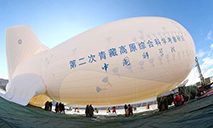Backgrounder: NATO's development and expansion
BRUSSELS, May 19 (Xinhua) -- Finland and Sweden on Wednesday formally submitted their applications to NATO Secretary-General Jens Stoltenberg, which will soon be under evaluation by the alliance, Stoltenberg said.
The full name of NATO is the North Atlantic Treaty Organization, which is a military-political alliance founded in 1949 by the United States and some European countries to contain the Soviet Union after World War II.
Its aim is that through political and military means, member states work together in collective defense and the maintenance of peace and security to promote democracy, the rule of law and welfare in the Euro-Atlantic region and defend the freedom and security of member states.
During the Cold War, NATO's adversary was the Warsaw Pact formed in 1955 by the Soviet Union and Eastern European countries. At the beginning of its establishment, NATO had only 12 member states: the United States, Belgium, Canada, Denmark, France, Iceland, Italy, Luxembourg, Norway, the Netherlands, Portugal and Britain. After eight rounds of expansion, there are currently 30 member states.
The first three rounds of expansion occurred during this period: in February 1952, Turkey and Greece joined NATO; in May 1955, the Federal Republic of Germany joined NATO; in May 1982, Spain joined NATO.
With the end of the Cold War, NATO began to implement a "Comprehensive Approach to Crisis Response" strategy, and by intervening in the crisis in the former Yugoslavia, to expand eastward.
Since 1992, Eastern European countries including Poland have successively put forward requirements to join NATO. In 1995, the alliance published the Study on NATO Enlargement.
In July 1997, the NATO Summit in Madrid decided to admit Poland, Hungary, and the Czech Republic to NATO. In March 1999, NATO officially accepted the three countries into the alliance, bringing the total number of members to 19.
At the summit held in Prague in November 2002, NATO decided to invite Estonia, Latvia, Lithuania, Slovakia, Slovenia, Romania and Bulgaria to the negotiations on accession. In March 2004, the above seven countries officially became members of NATO, raising the total to 26.
In April 2008, NATO leaders decided at their summit in Bucharest to encourage Western Balkan countries to join the alliance. After a series of negotiations and corresponding procedures, Albania and Croatia joined NATO in April 2009; Montenegro became a NATO member in June 2017, and North Macedonia officially joined in March 2020.
To apply for NATO membership, certain conditions must be met. According to Article 10 of the North Atlantic Treaty, the parties may, by unanimous agreement, invite any other European country in a position to further the principles of this treaty and to contribute to the security of the Euro-Atlantic area to accede to the alliance.
NATO has continuously adjusted its strategy of enlargement. The expansion during the Cold War was mainly for strategic reasons. After the Cold War, NATO enlargement was lively debated. It is in this context that the alliance carried out a Study on NATO Enlargement in 1995.
According to the study, countries seeking NATO membership would have to be able to demonstrate that they have fulfilled certain requirements, which include: a functioning democratic political system based on a market economy; the fair treatment of minority populations; a commitment to the peaceful resolution of conflicts; the ability and willingness to make a military contribution to NATO operations; and a commitment to democratic civil-military relations and institutional structures.
The procedure of NATO to accede new members is complicated. The first step is an accession negotiation. Then, the applicant country should formally submit a letter of intent to the NATO Secretary-General, confirming its willingness to undertake membership obligations and fulfilling its commitments, and submit a timetable. NATO will afterward draft an agreement for the applicant country.
All NATO member states must ratify the agreement according to their own domestic procedures and notify the U.S. government after approval, and then the Secretary-General of NATO will issue an invitation to the applicant country. After receiving the invitation, the applicant country will officially become a member of NATO after ratifying the agreement according to its own legislative procedures.
Photos
 China’s central bank to issue commemorative coins on cultural theme of auspiciousness, including two heart-shaped coins
China’s central bank to issue commemorative coins on cultural theme of auspiciousness, including two heart-shaped coins Population of endangered black-headed gulls exceeds 10,000 mark in NE China’s coastal city of Panjin
Population of endangered black-headed gulls exceeds 10,000 mark in NE China’s coastal city of Panjin China's self-developed floating airship breaks record
China's self-developed floating airship breaks record Chinese germplasm bank conserves biodiversity in warm temperate zone
Chinese germplasm bank conserves biodiversity in warm temperate zone
Related Stories
- Italy supports Finland-Sweden NATO bid: PM
- Washington hijacks ‘collective security of EU’ to serve anti-Russia strategy, benefit from NATO expansion
- Finland signs NATO admission request
- People protest against Sweden's decision to apply to join NATO in Stockholm
- Sweden, Finland to submit NATO applications Wednesday
Copyright © 2022 People's Daily Online. All Rights Reserved.






